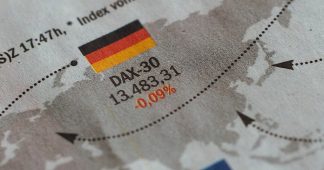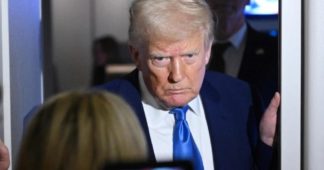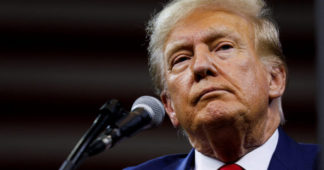Trump’s tariffs should be seen as an opportunity for Europeans to finally confront the deep flaws of the EU’s export-led economic model — a reckoning that is long overdue
On Friday, Donald Trump announced a staggering 50% tariff on European Union goods, set to take effect June 1, 2025, unless the EU agrees to significant trade concessions. This escalation from a previously reduced 20% tariff (now 10% until July 8) has ignited a firestorm of reactions, from diplomatic pushback to market turmoil.
Trump’s tariff proposal targets the EU’s $550 billion in annual exports to the US, compared to $351 billion in US exports to the EU in 2022. Citing “unfair” trade barriers and an imbalanced trade balance, Trump aims to force negotiations. The announcement follows a pattern of aggressive trade rhetoric, reminiscent of his first term, where tariffs were often proposed but sometimes softened after pushback. The EU, a critical US ally and the world’s largest trading bloc, now faces a pivotal moment in navigating this economic ultimatum.
EU leaders responded with measured restraint, signalling a desire to avoid a full-blown trade war while preparing for retaliation. Maros Sefcovic, the EU’s Commissioner for Trade and Economic Security, emphasised a commitment to a “deal based on respect, not threats”. Irish Prime Minister Micheál Martin called the tariff threat “enormously disappointing”, arguing it undermines a vital trading relationship and global economic stability. German Foreign Minister Johann Wadephul echoed this, warning that such tariffs would harm both economies and urging the EU to preserve market access.
The EU has already drafted $108 billion in retaliatory tariffs, targeting US goods like agricultural products and machinery. This preparation reflects lessons from Trump’s first term, when the EU countered US steel and aluminum tariffs with levies on American whiskey and motorcycles. Yet, public statements from Brussels project calm, suggesting a strategy to de-escalate while bracing for impact.
Financial markets reacted swiftly. Following Trump’s announcement, the STOXX 600 index plummeted 1.8%, with German automakers like BMW and luxury brands like L’Oreal and LVMH dropping 2-4%. US stock futures also fell, signalling broader economic unease. The European Commission, which had forecasted 0.9% GDP growth for the eurozone and 1.1% for the EU in 2025 based on a 10% tariff, now faces a bleaker outlook. A 50% tariff could significantly inflate prices for EU goods like Italian olive oil, French wine and German cars, potentially fuelling US inflation and pushing the EU toward recession.
Trump’s retreat on China tariffs suggests he may be open to compromise — but another reversal on that scale is unlikely, for several reasons. For starters, making another U-turn would be politically embarrassing for Trump. Moreover, the EU holds fewer cards than China. The US would be far less affected by a trade war with Europe than it would have been in a confrontation with China. Even if European imports were targeted by hefty tariffs, it’s unlikely that US store shelves would be left empty.
Furthermore, much of what is labeled as “Chinese exports” to the US are, in fact, American products manufactured in China — meaning the lion’s share of the value is captured by US corporations. As a result, it is these very companies that stand to be most harmed by the tariffs — one the main reasons for Trump’s backpedalling. This is not the case with European exports to the US.
But perhaps most crucially, Trump is right when he says the EU has been engaging in unfair trade practices. Over the past two decades — and especially in the aftermath of the 2010-2011 eurozone crisis — the European Union, despite being one of the wealthiest economic blocs in the world, has systematically suppressed domestic demand through policies of austerity, fiscal restraint and wage compression. This self-imposed deflationary trajectory (which further exacerbated the euro’s inherent deflationary bias) has not been accidental, but rather a deliberate strategy aimed at bolstering price competitiveness on the global stage, while at the same time reducing imports.
In effect, the EU has embraced a hyper-mercantilist, export-driven growth model, prioritising trade surpluses over internal economic development. This approach has come at the expense of both its own citizens, who face stagnating wages and underfunded public services, and its trading partners — most notably the United States — who have absorbed the EU’s export surpluses as part of an increasingly unbalanced global economic relationship.
Trump’s tariffs should therefore be seen as an opportunity for Europeans to finally confront the deep flaws of the EU’s export-led economic model — a reckoning that is long overdue. Meanwhile, in the short term, the EU could announced an economic and geopolitical rapprochement with China, further weakening the US’s leverage. Unfortunately, neither scenario is likely. The most probable outcome is that the EU will further align itself with Trump’s confrontational stance on China, hoping to secure trade concessions from the US — all in an effort to sustain an economic model increasingly rendered obsolete by the emerging post-liberal world order.
We remind our readers that publication of articles on our site does not mean that we agree with what is written. Our policy is to publish anything which we consider of interest, so as to assist our readers in forming their opinions. Sometimes we even publish articles with which we totally disagree, since we believe it is important for our readers to be informed on as wide a spectrum of views as possible.











